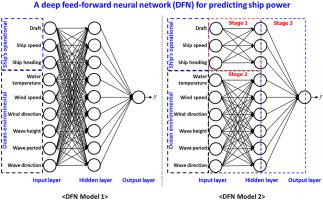International Journal of Naval Architecture and Ocean Engineering ( IF 2.2 ) Pub Date : 2021-08-12 , DOI: 10.1016/j.ijnaoe.2021.08.001 June-Beom Lee 1 , Myung-Il Roh 2 , Ki-Su Kim 3

|
Fuel oil consumption (FOC) must be minimized to determine the economic route of a ship; hence, the ship power must be predicted prior to route planning. For this purpose, a numerical method using test results of a model has been widely used. However, predicting ship power using this method is challenging owing to the uncertainty of the model test. An onboard test should be conducted to solve this problem; however, it requires considerable resources and time. Therefore, in this study, a deep feed-forward neural network (DFN) is used to predict ship power using deep learning methods that involve data pattern recognition. To use data in the DFN, the input data and a label (output of prediction) should be configured. In this study, the input data are configured using ocean environmental data (wave height, wave period, wave direction, wind speed, wind direction, and sea surface temperature) and the ship's operational data (draft, speed, and heading). The ship power is selected as the label. In addition, various treatments have been used to improve the prediction accuracy. First, ocean environmental data related to wind and waves are preprocessed using values relative to the ship's velocity. Second, the structure of the DFN is changed based on the characteristics of the input data. Third, the prediction accuracy is analyzed using a combination comprising five hyperparameters (number of hidden layers, number of hidden nodes, learning rate, dropout, and gradient optimizer). Finally, k-means clustering is performed to analyze the effect of the sea state and ship operational status by categorizing it into several models. The performances of various prediction models are compared and analyzed using the DFN in this study.
中文翻译:

基于深度前馈神经网络变化的舰船功率预测
必须将燃油消耗量 (FOC) 降至最低,以确定船舶的经济航线;因此,必须在航线规划之前预测船舶功率。为此,广泛使用了使用模型测试结果的数值方法。然而,由于模型测试的不确定性,使用这种方法预测船舶功率具有挑战性。应进行船上测试以解决此问题;然而,它需要大量资源和时间。因此,在本研究中,深度前馈神经网络 (DFN) 用于使用涉及数据模式识别的深度学习方法来预测船舶功率。要在 DFN 中使用数据,应配置输入数据和标签(预测输出)。在本研究中,输入数据使用海洋环境数据(波高、波浪周期、波浪方向、风速、风向和海面温度)和船舶的操作数据(吃水、速度和航向)。选择船舶功率作为标签。此外,还使用了各种处理方法来提高预测精度。首先,使用与船舶速度相关的值对与风和波浪相关的海洋环境数据进行预处理。其次,DFN 的结构根据输入数据的特征而改变。第三,使用包含五个超参数(隐藏层数、隐藏节点数、学习率、dropout 和梯度优化器)的组合来分析预测精度。最后,进行k-means聚类,通过将海况和船舶运行状态分类为多个模型来分析海况和船舶运行状态的影响。



























 京公网安备 11010802027423号
京公网安备 11010802027423号